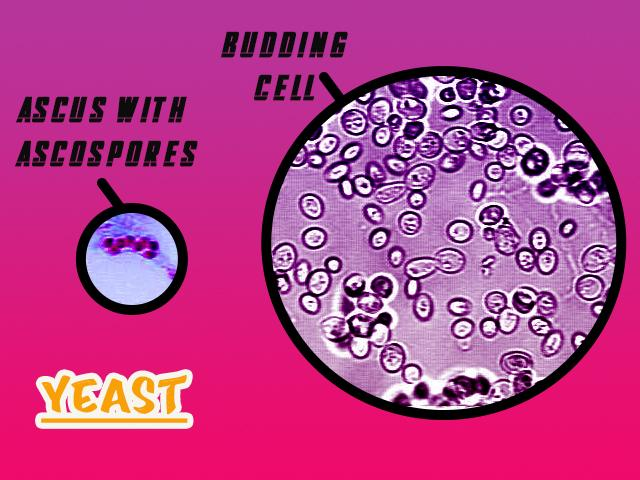
The meiospores of yeast are nonmotile and called-
(A)Aeciospores
(B)Aplanospores
(C)Ascospores
(D)Basidiospores
Answer
483k+ views
1 likes
Hint: The meiospores of yeast are nonmotile and are contained in an ascus or that was produced inside an ascus. This type of spore is particular to fungi classified as ascomycetes. Ascomycetes are spore shooters.
Complete answer:
The meiospores of yeast are nonmotile and called Ascospores. Ascospores are formed in ascus under optimal conditions. Typically, one ascus will contain eight ascospores (or octad). An ascus is defined as the sexual spore-bearing cell produced in ascomycete fungi.
Additional Information: Ascomycota - It is a phylum of the Fungi that, along with the Basidiomycota, forms the very known subkingdom Dikarya. Its members are commonly referred to as the sac fungi or ascomycetes. It's the biggest phylum of Fungi, with over 64,000 species. The eight spores are produced by the meiosis which is then followed by a mitotic division. Two meiotic divisions turn the first diploid zygote nucleus into four haploid ones. That is, the only original diploid cell from which the entire process begins contains two complete sets of chromosomes. In preparation for meiosis, all the DNA of both sets is duplicated, to form a complete of 4 sets. The nucleus that contains the four sets divides two times, due to which separating into four new nuclei – each of which has one complete set of chromosomes. Following this process, the four new nuclei duplicate its DNA and undergoes a division by the process known as mitosis. As a result, the ascus will contain 4 pairs of spores in it. Then the ascospores are released from the ascus.
So, the correct answer is ‘Ascospores’.

Note: Many of us get confused between Aeciospores and Ascospores. The Aeciospores are one of several different types of spores formed by Rusts. They each have 2 nuclei and are typically seen in the chain-like formations in the aecium.
Complete answer:
The meiospores of yeast are nonmotile and called Ascospores. Ascospores are formed in ascus under optimal conditions. Typically, one ascus will contain eight ascospores (or octad). An ascus is defined as the sexual spore-bearing cell produced in ascomycete fungi.
Additional Information: Ascomycota - It is a phylum of the Fungi that, along with the Basidiomycota, forms the very known subkingdom Dikarya. Its members are commonly referred to as the sac fungi or ascomycetes. It's the biggest phylum of Fungi, with over 64,000 species. The eight spores are produced by the meiosis which is then followed by a mitotic division. Two meiotic divisions turn the first diploid zygote nucleus into four haploid ones. That is, the only original diploid cell from which the entire process begins contains two complete sets of chromosomes. In preparation for meiosis, all the DNA of both sets is duplicated, to form a complete of 4 sets. The nucleus that contains the four sets divides two times, due to which separating into four new nuclei – each of which has one complete set of chromosomes. Following this process, the four new nuclei duplicate its DNA and undergoes a division by the process known as mitosis. As a result, the ascus will contain 4 pairs of spores in it. Then the ascospores are released from the ascus.
So, the correct answer is ‘Ascospores’.

Note: Many of us get confused between Aeciospores and Ascospores. The Aeciospores are one of several different types of spores formed by Rusts. They each have 2 nuclei and are typically seen in the chain-like formations in the aecium.
Latest Vedantu courses for you
Grade 11 Science PCM | CBSE | SCHOOL | English
CBSE (2025-26)
School Full course for CBSE students
₹41,848 per year
Recently Updated Pages
Master Class 11 Economics: Engaging Questions & Answers for Success

Master Class 11 Business Studies: Engaging Questions & Answers for Success

Master Class 11 Accountancy: Engaging Questions & Answers for Success

Master Class 11 English: Engaging Questions & Answers for Success

Master Class 11 Computer Science: Engaging Questions & Answers for Success

Master Class 11 Maths: Engaging Questions & Answers for Success

Trending doubts
1 Quintal is equal to a 110 kg b 10 kg c 100kg d 1000 class 11 physics CBSE

How much is 23 kg in pounds class 11 chemistry CBSE

Find the missing frequency in the following distribution class 11 maths CBSE

Difference between physical and chemical change class 11 chemistry CBSE

Whales are warmblooded animals which live in cold seas class 11 biology CBSE

Define least count of vernier callipers How do you class 11 physics CBSE




